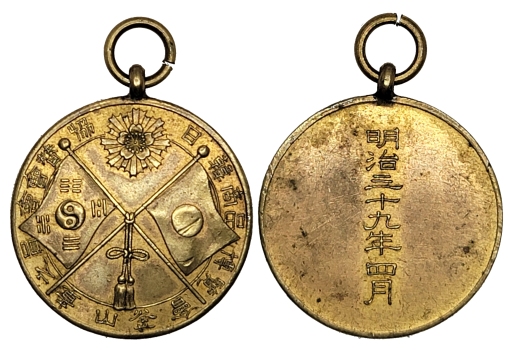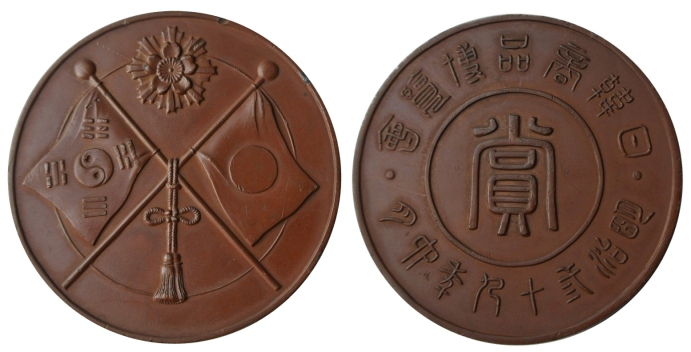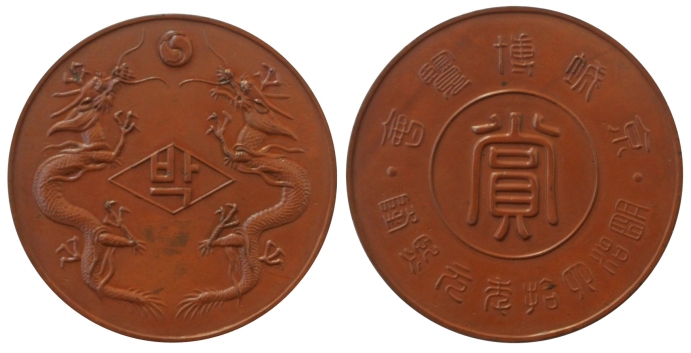International and Colonial World’s Fairs first began in the 1790s, with the first modern international exposition 박람회 (博覽會) being held in London in 1851.1 During the final half of the 19th century, until the early 20th century, international expositions were designed to function as political propaganda, both domestic and foreign, showcasing Western superiority. Host countries designed their expositions to show their power and promote their purported civilizing effect and skillful management of their colonial assets. Attendees were led to believe that with colonial assets, any nation could become an even more prosperous nation. When an imperial power held an exposition in one of their colonies, they were designed to embarrass the colony.
It wasn’t until the Paris Exhibition of 1867, that non-Western participants were first included on a large scale. Exhibits of colonial products and indigenous became a mainstay of early expositions. However, non-Western displays quickly became purely theatrical. The titillation of the audience with the exotic, the bizarre, the foreign curiosities and oddities, led to greater attendance and, more importantly, greater revenue. The inclusion of native displays also authenticated the fair as being a “World’s Fair’s”, and created a cosmopolitan flair, under the ever present guise of Western Superiority. Fair-goers saw it as an educational experience where they could visit a recreated native scenario, learn about that country, its culture, gawked at it, flirt with it, and indulge for a short time, without the expense of actually visiting the country. Non-Western displays were usually placed in areas far away from the more serious exhibits, however, these native exhibits more than pulled their weight in making sure that the fair turned a profit.
Fortunately, as time passed, expos were transformed from exhibitions of imperial power into venues of science and technology.
The first World’s Fair that Japan attended was the London World’s Fair in 1862. Japan held it first domestic exhibition in 1872 with its “Exhibition of Arts and Manufactures” 第1回京都博覧会, held in Kyoto.2 The Meiji government’s first official foreign participation was at the Vienna World’s Fair in 1873. However, there are references that Japan participated in the “Exposition Universelle” of 1867 in Paris, but it is unclear if this was an official or unofficial exhibition. The Japanese Empire quickly recognized and utilized exhibitions as a powerful national policy. In the 37 years between 1873 and 1910, Japan participated in 37 world exhibitions. They became very skillful at presenting Japan as a very traditional country, while at the same time selling itself as a modern, industrial nation.
According to “Korea’s Modern Exposition,” by Lee Gak-gyu, King Kojong had visited the Vienna World Exposition in 1873, where the participation of Japan ignited “Japonism” fever in Europe.3 However, I cannot find any information of Kojong ever leaving Korea during his lifetime. It is more likely that King Kojong sent a group of people to observe the exposition and report back.

As early as the 1880s, Korean King Kojong 고종 was interested in promoting his nation externally. He established the Office of Extraordinary State Affairs 통리기무아문 (統理機務衙門) to manage foreign affairs and to coordinate the reform programs. It was dedicated to diplomacy and enlightenment. In 1881, Koreans were dispatched to visit the Second National Exposition for the Promotion of Industry 내국권업박람회 (內國勸業博覽會) held in Ueno Park, Tokyo.4 In Sept. 1883, Koreans visited the Boston Business Fair 보스턴기업박람회 in the United States where they had an informal exhibit.5 King Kojong wanted an exhibition in Korea, as evidenced by an October 23, 1883, New York Times article “Corea to Have an Exhibition”, unfortunately it failed to materialize, the timing wasn’t right, and the funding wasn’t available. Korea had another unofficial exhibit at the 1889 World’s Fair in France.6 Despite the failed attempt to hold a major exposition in Korea in the mid-1880s, Korea’s reformist administration continued to seek participation in international expositions. Korea actively exhibited at the Chicago World’s Fair 시카고세계박람회와 in 1893, and the Paris World’s Fair 파리세계박람회 in 1900. Some Korean exhibit items at the Chicago World’s Fair are currently in the Peabody Essex Museum in Salem, Massachusetts, the Field Museum in Chicago, the Penn Museum in Philadelphia, and in the Smithsonian Institution. Several Korean exhibit items at the Paris World’s Fair are currently in the French National Musée des Arts et Métiers (Museum of Crafts and Arts), the Le Musée de la Musique (Musical Instruments Museum of the National Conservatory), and the Musée National des Arts Asiatiques-Guimet (Guimet National Museum of Asiatic Art).7 At the Paris World’s Fair, the Korean Empire received the Grand Prize for processed agricultural products and received 2 Gold Medals, 10 Silver Medals, 5 Bronze Medals, and 3 Honorable Mentions.8 In 1901, King Kojong awarded various classes of the Order of the Eight Trigrams to eight French officials and organizers of the Korean Pavilion, including Count Mimerel, C. Roulina, E. Ferret, M. Curant, and P. M. Saltarel.9 The French Minister to Korea, Victor Émile Marie Joseph Collin de Plancy (1853–1924)10 who had arranged for the Korean Exhibit in Paris, also arranged for the Korean Empire to exhibit at the Hanoi (French Indo-China) World’s Fair from 1901 to 1902.11 King Kojong created laws related to holding expositions in Korea. In March 1895, the ‘Rules of the Ministry of Agriculture and Commerce’ 농림부 규칙 were promulgated as Decree No. 48, and in August 1899, the ‘Temporary Exposition Office Rules’ 임시박람회사무소규칙 were promulgated by Order No. 39. In 1902, a Provisional Exposition Department 림시박람회사무소 (臨時博覽會事務所)12 was established, and in September, the enforcement regulations were prepared, and specific activities begun. The year 1903 saw the building of the Provisional Exposition Display Hall 림시박람회진렬관 (臨時博覽會陳列館) which was a permanent exhibition hall for commercial and industrial products, in Seoul. However, in July 1904, the Provisional Exposition Department 임시박람회 사무소관제 of the Ministry of Agriculture and Commerce 농상공부관제 was abolished, and an Exposition Department 임시박람회 사무소관제 was created. By 1904, the Provisional Exposition Display Hall was closed and in its place, the government had established the Department of Exposition and Industrial Promotion 박람회권업과 (博覽會勸業課). Korea’s first trade fair, was held in Pusan in April 1906, and later, from Sept. 1 through Nov. 15, 1907, the Jeon-Choson Railroad Expo 전조선철도박람회가 (Possibly also known as The Railway Exposition 련선기차박람회 (聯線汽車博覽會)). Earlier in April 1907, a commercial and industrial museum, affiliated with the Kyŏngsŏng (Seoul) Chamber of Commerce, was opened. An exposition was scheduled for 1910, but with the annexation of Korea, it never took place.
Some 173 expositions and symposiums were held in Korea during the 36 years of Japanese occupation (1910 to 1945). While the initial expositions were used to spotlight Japan and Japanese goods, later expositions gradually turned more political and were used to disseminate political propaganda and to demonstrate colonial achievements under the Japanese occupation.
1906 Japanese/Korean Goods Exposition – Pusan, Korea 日韓商品博覽會

Obverse, right side: Japan/Korean Goods Exposition.
日韓商品博覧會 (일한상품박람회)
Obverse, left Side: Member of the Sponsoring Association
協賛會會員之章 (협찬회회원지장)
Obverse, bottom: Pusan 釜山 (부산)
Reverse: Meiji 39 [1906] April 明治三十九年四月 (명치삼십구년사월)

Reverse, top: 日韓商品博覽會 (일한상품박람회) Japanese/Korean Goods Exposition
Reverse, bottom 明治三十九年四月 (명치삼십구년사월) Meiji 39 year, 4th month (April 1906)
Reverse, center 賞 (상) A prize, an award, a reward
Picture source: https://blog.naver.com/ruler01/220935987476
In 1876, Pusan became the first international port in Korea under the terms of the (unequal) Treaty of Ganghwa. The Pusan Japan Chamber of Commerce was founded in 1879, and originally called the Commercial Chamber of Commerce 상법회의소 (商法會議所). The plan for the 1906 Japanese-Korean Merchandise Exposition can be traced back to 1902 with the opening of the Pusan Japanese Commercial Museum. Located originally in a small exhibition hall, the museum was officially, reopened on April 16, 1905, in a newly constructed, three story western style brick building in (present day Gwangbok-dong 광복동 (光復洞)) Pusan. At the time, it was the largest building in Pusan. On the surface, the building was to display products from Korea and Japan, but in reality, the displays were primarily about goods from Osaka, Japan. The Product Exhibition Hall had almost 300,000 Japanese products on display. The opening of the Gyeongbu Railway 경부철도 京釜鐵路 (京釜線) on Jan. 1, 1905 contributed to the economic growth of the region, and also facilitated visitors wishing to attend the exposition. On September 11, 1905, the Bukwan Train Ferry 釜關連絡船 (부관련락선) was created by the Sanyo Kisen Co., Ltd. 산요기선주식회사 (山陽汽船株式會社) to connect the railway in Pusan to the docks in Shimonoseki, Kyushu, Japan. However, the rail gauges in Korea and Japan were different, so they could not ferry rail cars. Beginning on Nov. 1, 1911, trains could also go to Manchuria, making it an truly international railway.
Unfortunately, even with all Kojong’s desires to host an exhibition, it was the Japanese, who took the initiative and organized the 1906 Japanese-Korean Merchandise Exposition 일한상품박람회 (日韓商品博覽會). It was Korea’s first such exposition and ran from April 25th to July 25th, 1906. Although billed as a joint event, co-hosted by Korea and Japan, it was controlled by the private business sector, most notably, the members of the Japanese Chamber of Commerce and Industry. It appears that the Korean involvement was primarily used to entice Koreans to come to the exhibition. Japan’s primary purpose for the exposition was to give Koreans a positive impression of Japan, while humiliating Korea as being backwards and needing Japanese guidance. The first Japanese Resident-General of Korea, Itō Hirobumi (伊藤博文) (1841-1909), donated 300 won to the Exposition, while the Korean government offered 5,000 won, which ultimately was the largest donation supporting the Exposition.
Some 316,172 products covering some 1741 different categories were exhibited at the 1906 Exposition.13 One source claims that 85,009 people attended (26,130 Koreans and 58,879 foreigners). Another source places the total at 77,009 visitors with approximately 48,996 Japanese, 26,130 Korean, 625 Chinese, and 458 foreigners. At the time, Pusan had an approximate population of 38,000 and due to the large number of visitors, the 1906 Exposition was considered to be the largest major event in the history of the city up to that time.
Ishihara Hanemon (石原半右衛門) (1847-1930), who was the head of the Japanese Pusan residents community, organized an Exposition Sponsor Association (協贊會) which exclusively involved the Japanese settler community. The medal at the left was issued by, and for, the members of that association. The minimal Korean involvement was masked by setting up a Korean Sponsor Association with Korean businessmen and officials, including Pak Yŏng-kil (朴永吉) who served as the president of the association. The Korean Sponsor Association encouraged the submission of Korean exhibits and made efforts to attract Korean visitors. They provided exhibit labels in Korean and offered services such as female guides for Korean female visitors. The Korean Sponsor Association also continued to play an important role in the planning of subsequent expositions and events and in attracting visitors to later Korean expositions, including the 1915 Chosŏn Industrial Exposition.
The Product Exhibition Hall utilized during the exposition became a permanent fixture after the fair. In 1909, Korean Emperor Sunjong took a tour of the southern provinces. While in Pusan, he visited the Pusan Products Showcase on Jan. 9, 1909.
1907 Japanese/Korean Goods Exposition 京城博覽會
It is frequently assumed that the 1907 Kyŏngsŏng (Seoul) Exposition 京城博覽會 was the first “effective” exposition held in Korea. It was the first international exposition to be staged in the capital, Kyŏngsŏng14, but the first such event, officially titled “exposition”, was the 1906 Japanese-Korean Merchandise Exposition 日韓商品博覽會 in Pusan. There was also the April 1907 Railway Train Expo held in Inchon.
The 1907 Japanese/Korean Goods Exposition was held from September 1 through November 15, 1907. Like the previous exhibition, it was presented as a joint event, staged by both Japanese and Korean businessmen (with the support of the Residency-General of Korea and the Korean government), under the administration of the Korean Ministry of Agriculture, Commerce. However, the key organizers were Japanese officials from the office of the Residency-General, which included the Minister of the General Affairs, Tsuruhara Sadakichi (鶴原定吉) (1857-1914), and Ogawa Tsuruji (小川鶴二). The site of the 1907 exposition was on Koganemachi Street 黃金町通 which, at the time, was in the heart of the Japanese community in Seoul.15 The Korean Government donated 25,000 won, which was a considerable amount of money. The 1907 Exposition more closely resembled an open market than an exhibition. Basic products were exhibited that were not only available for inspection, but also for immediate purchase. Later expositions in Korea were more focused on the display of state-of-the-art goods, luxury products and the dissemination of Japanese propaganda. The 1908 Annual Report of the Administration in Korea stated that a total of 79,126 exhibits were on display but only, 4500 items were Korean, while approximately 74,600 items were Japanese. There were only 23 Korean vendors who managed to exhibit goods at ten displays, while Japanese merchants had over 160 exhibits of Japanese products. This was a clear indication of the economic dominance of Japan in Korea, even before formal annexation. The promotion of Japanese commercial and political interests over Korean interest, was so blatant, that some Westerners, living in Korea at the time, were calling it the “Japanese Exposition”. The 1907 Kyŏngsŏng Exposition provided the first opportunity for large numbers of Koreans to experience an exposition. The exposition did have an Exposition Sponsor Association, but I have been unable to locate any medals that may have been produced by that association. In total, some 208,417 people visited the Exposition, with approximately 73 to 75% of them being Koreans.
Because of the low attendance, government officials and Japanese settlers regarded the 1907 Kyŏngsŏng Exposition as a failure, and they wanted to stage a larger and hopefully a more successful exposition in Seoul.

The Korea word in the center of the obverse is 박 surounded by a diamond, which commonly translates as “Gourd” (which would include cucumbers, melons, squash, and pumpkin (a plant 植)). As a suffix -박 (-泊) it translates as “a stay, an excursion”, but here, it
is shorthand for박람회 (博覽會) an exhibition, an exposition, a fair.
Photo credit: https://cafe.naver.com/dodohi0607/109283


Footnotes:
- “The Great Exhibition of the Works of Industry of All Nations”, also known as the “Great Exhibition” or the “Crystal Palace Exhibition” is typically listed as the first World’s Fair.
- The exhibition was held from March 10 through May 30, 1872, at three Buddhist temples (西本願寺, 建仁寺, 知恩院) and attracted large numbers of foreigners. The exposition was held almost every year through 1928.
- Located on a web page of the Korea JoongAng Daily. Article entitled “Headed for Expo 2012? Road to Yeosu begins at the 1893 Chicago fair”.
- Japans first National Exposition for the Promotion of Industry was held in 1877, and was repeated in 1881, 1890, 1895 and in 1903.
- The “American Exhibition of the Products, Arts and Manufactures of Foreign Nations” was held in 1883 and 1884.
- The Eiffel Tower was erected specifically for this Exposition.
- The Musée Guimet had already opened their Korean Gallery in 1893.
- The organizers of the Exposition were not miserly in recognizing the 83,047 exhibitors. The awards ceremony was held on August 18, 1900, and was attended by 11,500 persons. The awards included 3,156 grand prizes, 8,889 gold medals, 13,300 silver medals, 12,108 bronze medals, and 8,422 honorable mentions.
- The book “Korean Empire Era, Decoration System” 대한제국시대 훈장제도 by Yi Kang-chil, 이강칠 (李康七), gives details about these eight awards with listings for the Order of the Eight Trigrams on May 31, 1901 (two 2nd Class, one 3rd Class, four 4th Class) and on Dec. 21, 1901 (one 3rd Class).
- Victor Colin de Plancy stayed in Korea as the Plenipotentiary Minister and as the Consul-General of France, 1887-1890 and 1896-1906.
- ”Indo China Exposition Français et Internationale”
- Some sources refer to a Temporary Exhibition Office 임시박람회 사무소가
- Other sources state that the Exposition displayed 319,172 exhibits submitted by 542 Japanese and 38 Korean exhibitors.
- Seoul was known in the past by several names: Wiryeseong 위례성 (慰禮城), during the Paekche era; Hanyang 한양 (漢陽), during the Koryo era; Hansŏng 한성 (漢城), during the Yi Dynasty; Hwangsŏng 황성 (皇城), as the Imperial Capital of the Korean Empire (1897-1910) and as Kyŏngsŏng 경성 (京城) or Keijō (京城) during Japanese Protectorate and Annexation periods.
- Today Ulchiro 을지로 乙支路.
